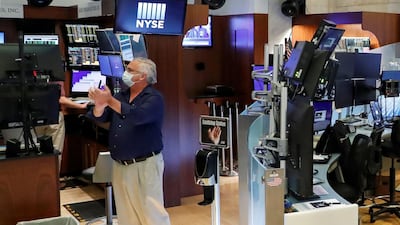US equity markets are continuing their stellar run with the Dow Jones Index gaining more than 4 per cent to close last week above 25,500 – that’s an 11-week high. Similarly, the Nasdaq and S&P500 gained 2 per cent and 3.6 per cent respectively, with the latter closing above 3000 for the first time since early March.
The turnaround in US equity markets is remarkable to say the least. Optimism around the potential of a vaccine, re-openings after extended lockdowns and the effects of the record stimulus introduced by the US Federal Reserve have seen the Dow Jones rally more than 38 per cent since those March lows. This brings its losses on the year to only 11 per cent. Similarly, the S&P Index, has rallied more than 39 per cent since March, bringing its losses on the year to only 5.5 per cent.
US equities continue to remain a fashionable proposition heading into the summer months. A recent survey by the Bank of America showed the percentage of fund managers who valued US stocks as attractive has risen to its highest level in almost five years. Much of this can be attributed to investors hunting for more attractive returns; the S&P’s dividend yield at roughly 2.05 per cent trumps the 0.66 per cent currently on offer on the 10-year treasury note.
While the recent rally in US equities is impressive, I am still guarded against an extended rally. We still have no sustained signs of clarity on how this pandemic will pan out and we are yet to see the deeper effects on the economy as the second quarter data releases filter through.
The number of people out of work is continuing to rise and one crucial indicator I follow, which throws further shade on the rebound in US equities, is the Buffet Indicator. This compares the total US stock market capitalisation against the US gross domestic product with the current figure suggesting the total market index is at a staggering 140 per cent of GDP. This tells me it is an overheated stock market.
One of the key themes driving volatility last year was the US-China trade war. Despite a bilateral understanding between the two nations at the end of the year, tensions have started boiling again. Since the outbreak of the pandemic, the Trump government has blamed China for failing to control and contain the virus. Last week Donald Trump said he'd directed his administration to start the process of revoking special treatment for Hong Kong; this was in response to China’s plans to impose new legislation on the island.
Reports earlier this week suggested China retaliated by instructing it’s state-owned companies to stop purchases from the US, such as soybeans. To put this into perspective, China imported more than $1 billion (Dh3.67bn) worth of soybeans in the first quarter of this year alone. This represents more than 10 per cent of the total US exports to China. While these reports are unconfirmed, it shows how quickly tensions can rise. If the situation escalates further, it will put January's phase one trade deal at risk.
At the end of last week, US unemployment claims surpassed 40 million and while we do not expect to see losses to match April’s 20 million print, there are expectations for job losses of about 8 million in May with overall unemployment coming in at just under 20 per cent.
A couple of key central bank releases to note this week include the Reserve Bank of Australia’s rate decision, which was unchanged at 0.25 per cent. On Wednesday, we await the US ADP employment report followed by the Bank of Canada rate decision, which is expected to be unchanged at 0.25 per cent. On Thursday the European Central Bank is set to announce interest rates, expected unchanged at 0 per cent, and the European monetary policy statement is due, which should see volatility in euro crosses.
As for me, I continue to enjoy opportunities in gold by building long positions between $1,700 and $1,710 with a stop loss at $1,692 and the option to take profit at $1,740 levels.
Gaurav Kashyap is a market strategist at Equiti Global Markets. The views and opinions expressed in this article are those of the author and do not reflect the views of Equiti


